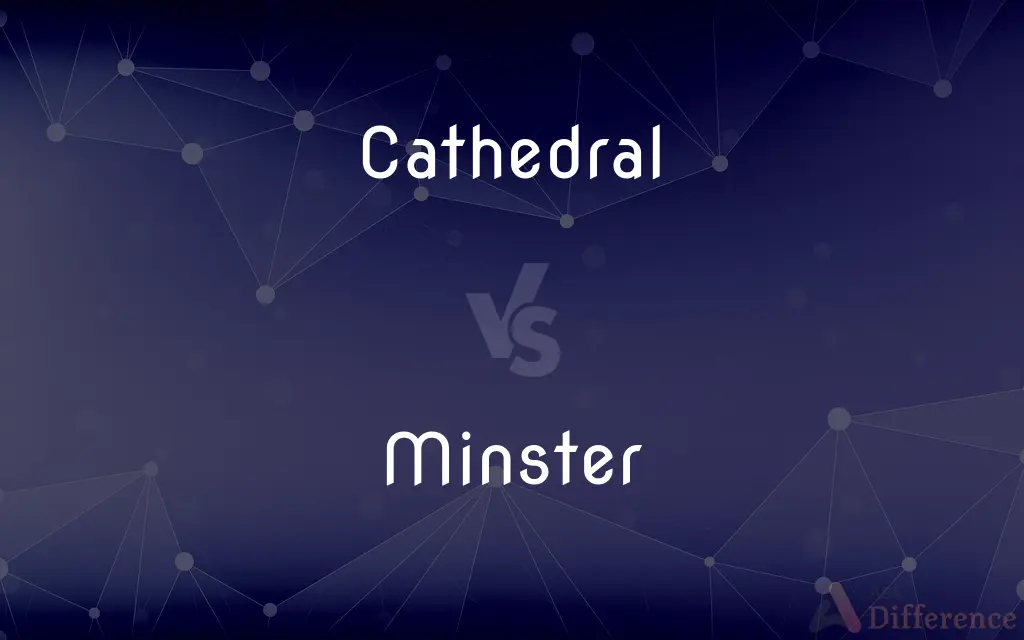Cathedral vs. Minster — What's the Difference?
By Tayyaba Rehman & Fiza Rafique — Updated on February 29, 2024
Cathedrals are central diocesan churches with a bishop's seat. Minsters are Anglo-Saxon missionary or monastic churches, not tied to bishops but to early Christian work.

Difference Between Cathedral and Minster
Table of Contents
ADVERTISEMENT
Key Differences
Cathedrals and minsters are both significant in the Christian religious landscape, but they serve different historical and ecclesiastical functions. The term "cathedral" comes from the Latin 'cathedra,' meaning 'seat,' referring to the presence of the bishop's official seat, symbolizing the church's role as the administrative center of a diocese. Minsters, on the other hand, have their roots in the Anglo-Saxon and medieval Christian traditions of Britain. Originally, the term was associated with monastic churches or those established during the early Christianization of England, serving as centers for missionary work, education, and religious practice.
Cathedrals are pivotal in hosting major liturgical acts, celebrations, and the bishop's ceremonies, reflecting their importance in church hierarchy and governance. While some minsters, due to their size, historical importance, or location, may also function as cathedrals, the term itself does not imply a cathedral's ecclesiastical status but rather highlights the church's foundational missionary or monastic role.
The architectural and historical significance of cathedrals often reflects their central role in Christianity, with many being architectural masterpieces that attract visitors from around the world. Minsters, while they may also be architecturally significant, are more varied in their designs, sizes, and functions, with their importance often tied to their historical role in spreading Christianity and serving community religious needs.
The distinction between cathedrals and minsters can sometimes blur, especially in places where historical minsters have assumed modern cathedral functions. However, the primary difference remains in their origins and roles: cathedrals as seats of bishops and symbols of diocesan authority, and minsters as representatives of the early Christian church's missionary
Comparison Chart
Definition
A Christian church housing a bishop's seat.
A church associated with missionary work or monastic life.
ADVERTISEMENT
Origin of Term
From the Latin 'cathedra,' meaning 'seat.'
Old English 'mynster,' from Latin 'monasterium.'
Primary Function
Administrative center of a diocese.
Early Christian missionary and education center.
Architectural Significance
Often grand and architecturally notable.
Can vary widely, historically significant.
Ecclesiastical Role
Symbolizes church hierarchy and governance.
Emphasizes historical missionary or monastic role.
Relationship with Bishop
Direct, as it contains the bishop's cathedra.
Indirect, not necessarily associated with a bishop's seat.
Compare with Definitions
Cathedral
A symbol of ecclesiastical authority.
The cathedral stands as a testament to the church's enduring presence.
Minster
Originally a missionary church or monastic foundation.
York Minster was founded as a missionary church in the early Christian period.
Cathedral
Reflects the church's hierarchical structure.
As the diocesan center, the cathedral hosts the bishop's official functions.
Minster
May or may not function as a cathedral.
Southwell Minster serves as a parish church rather than a cathedral.
Cathedral
The principal church of a diocese, containing the bishop's seat.
The Cathedral of Notre Dame is a historic site in Paris.
Minster
Varied in architectural styles, reflecting local influences.
The minster's architecture blends Norman and early English elements.
Cathedral
Central to diocesan liturgical activities.
Major ceremonies are held at the cathedral during Easter.
Minster
Historically significant in spreading Christianity.
The minster played a key role in educating the local population about Christianity.
Cathedral
Architecturally significant, often featuring Gothic or Romanesque styles.
The cathedral's stained glass windows are renowned worldwide.
Minster
A center for community and religious life.
The minster remains a focal point for community gatherings and services.
Cathedral
A cathedral is a church that contains the cathedra (Latin for 'seat') of a bishop, thus serving as the central church of a diocese, conference, or episcopate. Churches with the function of "cathedral" are usually specific to those Christian denominations with an episcopal hierarchy, such as the Catholic, Anglican, Eastern Orthodox, and some Lutheran churches.
Minster
A monastic church.
Cathedral
The principal Christian church building of a bishop's diocese
Minster
A monastery church.
Cathedral
The principal church of a bishop's diocese, containing the episcopal throne.
Minster
A large church, especially a collegiate church or a cathedral.
Cathedral
A large, important church.
Minster
A church of a monastery. The name is often retained and applied to the church after the monastery has ceased to exist (as Beverly Minster, Southwell Minster, etc.), and is also improperly used for any large church.
Cathedral
Something that resembles a cathedral, as in grandeur or authority.
Cathedral
Of, relating to, or containing a bishop's throne
A cathedral church.
Cathedral
Relating to or issuing from a chair of office or authority; authoritative.
Cathedral
The principal church in a diocese, so called because in it the bishop has his official chair (Cathedra) or throne.
Cathedral
Pertaining to the head church of a diocese; as, a cathedral church; cathedral service.
Cathedral
Resembling the aisles of a cathedral; as, cathedral walks.
Cathedral
Any large and important church
Cathedral
Relating to or containing or issuing from a bishop's office or throne;
A cathedral church
Common Curiosities
What makes a church a cathedral?
A church becomes a cathedral when it contains the official seat (cathedra) of a bishop, serving as the administrative center of a diocese.
What is the historical significance of minsters?
Minsters are historically significant for their roles in the early Christianization of regions, serving as centers for missionary work, education, and monastic life.
What is the role of a cathedral in the church hierarchy?
Cathedrals serve as the central church of a diocese, symbolizing ecclesiastical authority, and hosting major liturgical and ceremonial functions of the bishop.
How do architectural styles differ between cathedrals and minsters?
Cathedrals often feature grand architectural styles like Gothic or Romanesque, while minsters can vary widely, reflecting their historical and local context.
How does one determine if a church is a cathedral or a minster?
The designation depends on the church's function: if it contains a bishop's seat, it's a cathedral; if its origins or functions are tied to missionary work or monastic life, it's traditionally called a minster.
Can a minster also be a cathedral?
Yes, some minsters may also function as cathedrals if they house a bishop's seat, but this is not inherent in the term 'minster.'
Do all dioceses have cathedrals?
Yes, each diocese typically has a cathedral that serves as the central church and administrative center.
Why are some churches called minsters?
The term 'minster' is derived from the Anglo-Saxon and medieval traditions, referring to churches founded for missionary work or as part of a monastic establishment.
Is there a difference in the community role between cathedrals and minsters?
While both serve as centers for worship and community, minsters historically emphasize their role in education and missionary efforts, whereas cathedrals focus on diocesan governance and liturgical celebrations.
Can the terms cathedral and minster be used interchangeably?
While there may be overlap in some cases where a minster also functions as a cathedral, the terms are not interchangeable due to their distinct historical and ecclesiastical meanings.
Share Your Discovery

Previous Comparison
Pathologist vs. Coroner
Next Comparison
Account vs. SatisfactoryAuthor Spotlight
Written by
Tayyaba RehmanTayyaba Rehman is a distinguished writer, currently serving as a primary contributor to askdifference.com. As a researcher in semantics and etymology, Tayyaba's passion for the complexity of languages and their distinctions has found a perfect home on the platform. Tayyaba delves into the intricacies of language, distinguishing between commonly confused words and phrases, thereby providing clarity for readers worldwide.
Co-written by
Fiza RafiqueFiza Rafique is a skilled content writer at AskDifference.com, where she meticulously refines and enhances written pieces. Drawing from her vast editorial expertise, Fiza ensures clarity, accuracy, and precision in every article. Passionate about language, she continually seeks to elevate the quality of content for readers worldwide.
















































